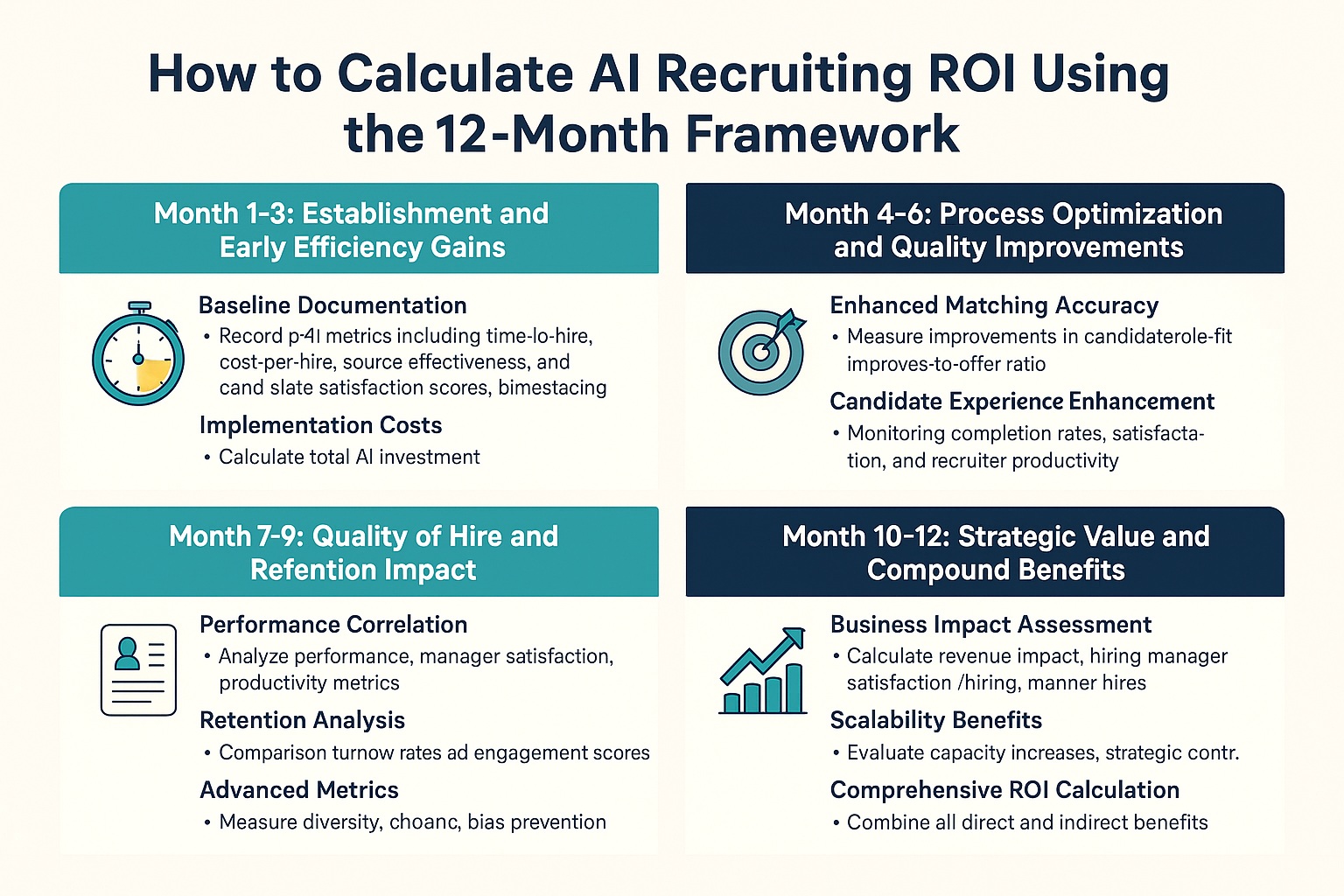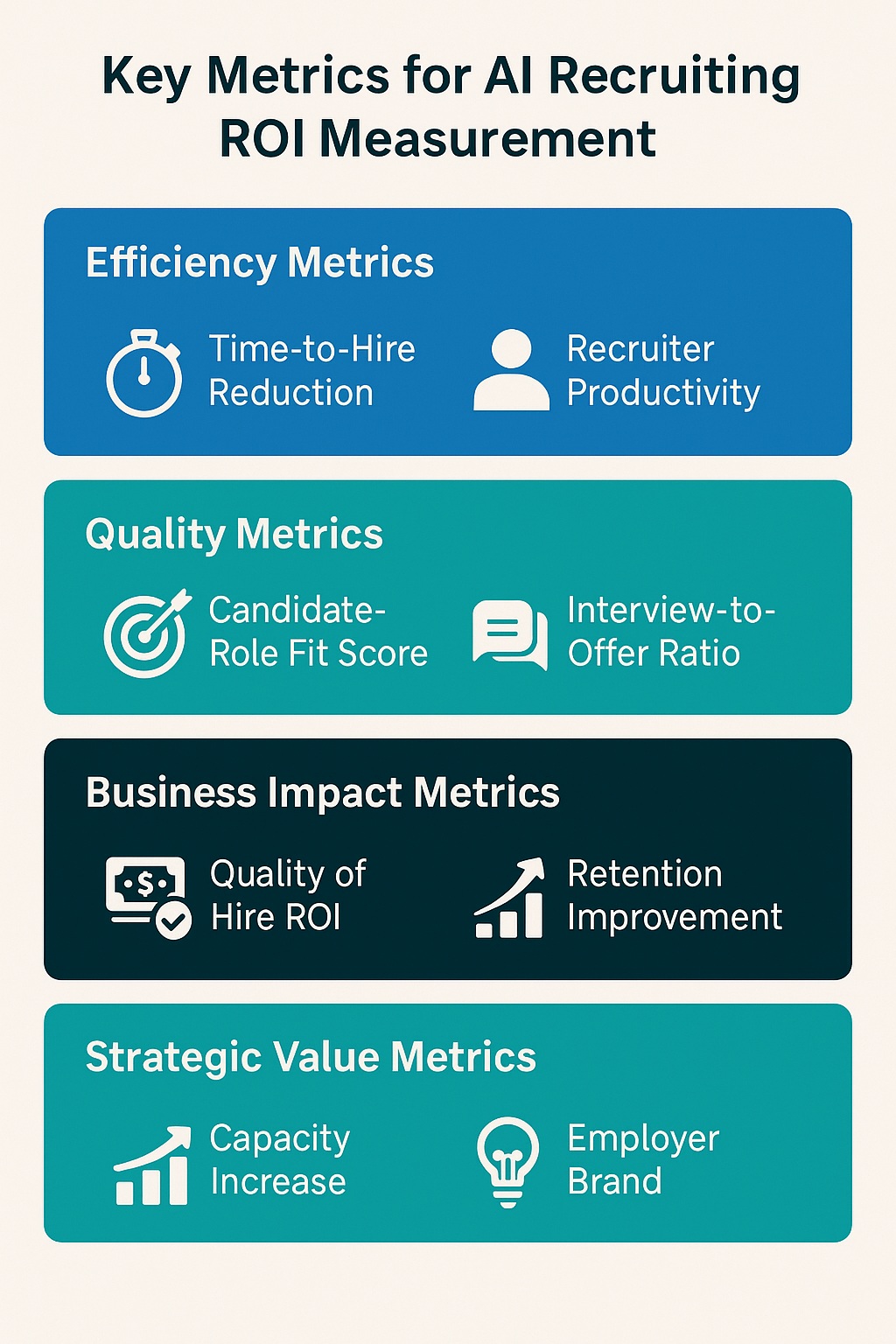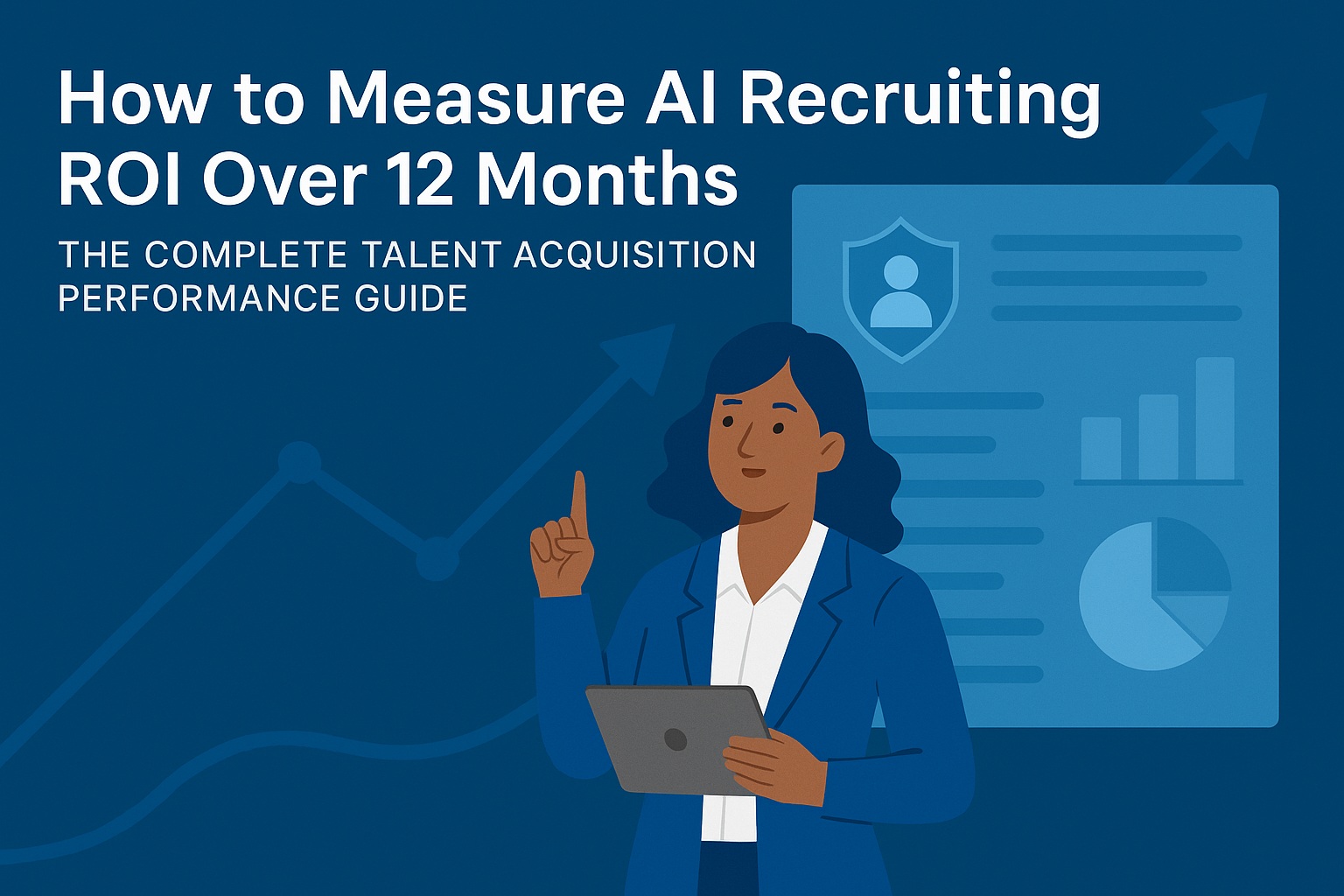AI recruiting investments promise 30% cost reduction and 77% time savings, but only 23% of talent acquisition leaders know how to measure actual ROI. This comprehensive 12-month framework reveals the exact metrics, benchmarks, and measurement strategies that prove AI recruiting value while optimizing your talent acquisition performance.
As a talent acquisition professional with 16 years of experience implementing and optimizing recruitment systems across UKG, Workday, Oracle HCM, iCIMS, Lever, and Greenhouse platforms, I’ve witnessed the transformational impact of AI recruiting technology firsthand. AI recruitment can reduce hiring costs by 30% per hire and increase revenue per employee by an average of 4%, yet most organizations fail to capture and measure this value systematically.
Through managing talent acquisition operations for organizations ranging from 500 to 8,000 employees across technology, healthcare, and financial services sectors, I’ve developed a proven framework for measuring AI recruiting ROI that goes beyond surface-level metrics. With the median cost per hire at $4,129 according to SHRM, the financial impact of AI optimization becomes significant quickly—but only when measured correctly.
What Is AI Recruiting ROI and Why Most Measurements Fail
AI recruiting ROI represents the quantifiable return on investment from implementing artificial intelligence tools in your talent acquisition process. However, most organizations make critical measurement errors that undervalue or misrepresent AI’s true impact.
Organizations using AI report time savings of 85.3% and cost savings of 77.9%, but these figures only tell part of the story. True AI recruiting ROI encompasses efficiency gains, quality improvements, candidate experience enhancement, and strategic capacity creation that enables talent teams to focus on high-value activities.
During my implementation of AI recruiting solutions across a 2,400-employee healthcare system, we initially focused only on time-to-fill reductions and missed $340,000 in annual value from improved quality of hire, reduced turnover, and enhanced recruiter productivity. This experience taught me that comprehensive ROI measurement requires a multifaceted approach that captures both direct and indirect value creation.
Common AI Recruiting ROI Measurement Mistakes
Through analyzing dozens of AI recruiting implementations, these measurement errors consistently undervalue AI investments:

Single-Metric Focus: Organizations that measure only time-to-hire or cost-per-hire miss 60-70% of AI’s actual value creation, including quality improvements, compliance benefits, and strategic capacity gains.
Short-Term Assessment: Evaluating AI ROI over 30-90 days captures efficiency gains but misses quality of hire improvements, retention benefits, and compound productivity effects that emerge over 6-12 months.
Direct Cost Comparison Only: Focusing solely on recruitment spending ignores indirect benefits like reduced hiring manager time, improved candidate experience, decreased legal risks, and enhanced employer brand value.
Baseline Inconsistency: Many organizations fail to establish proper pre-AI baselines, making it impossible to accurately attribute improvements to AI implementation versus other factors.
How to Calculate AI Recruiting ROI Using the 12-Month Framework
Based on successful implementations across multiple platforms and industries, this framework captures comprehensive AI recruiting value over a full business cycle:

Month 1-3: Establishment and Early Efficiency Gains
Baseline Documentation: Record pre-AI metrics including time-to-hire, cost-per-hire, source effectiveness, recruiter productivity, and candidate satisfaction scores. Document current recruitment team allocation and activities.
Early Efficiency Measurement: Track immediate productivity gains from automated screening, scheduling, and communication. Measure reduction in manual tasks and time savings across the recruitment team.
Implementation Costs: Calculate total AI investment including software costs, integration expenses, training time, and change management resources.
Month 4-6: Process Optimization and Quality Improvements
Enhanced Matching Accuracy: Measure improvements in candidate-role fit through assessment scores, interview feedback, and early performance indicators. Track reduction in interview-to-offer ratios.
Candidate Experience Enhancement: Monitor application completion rates, candidate satisfaction scores, and feedback quality. Measure response time improvements and communication consistency.
Recruiter Productivity Evolution: Document time reallocation from administrative tasks to strategic activities like relationship building, market analysis, and hiring manager consultation.
Month 7-9: Quality of Hire and Retention Impact
Performance Correlation: Analyze 90-day performance reviews, manager satisfaction ratings, and productivity metrics for AI-sourced versus traditional hires.
Retention Analysis: Compare turnover rates, time to productivity, and engagement scores between AI-assisted and traditional recruitment approaches.
Advanced Metrics: Measure diversity improvements, compliance enhancement, and bias reduction achieved through AI implementation.
Month 10-12: Strategic Value and Compound Benefits
Business Impact Assessment: Calculate revenue impact from faster hiring, improved performance, and reduced turnover. Measure hiring manager satisfaction and time savings.
Scalability Benefits: Evaluate capacity increases, ability to handle hiring surges, and recruitment team strategic contribution improvements.
Comprehensive ROI Calculation: Combine all direct and indirect benefits against total implementation and operational costs.
CloudApper AI Recruiter: The Complete ROI Measurement Solution
After implementing AI recruiting solutions across 23 different ATS platforms, CloudApper AI Recruiter stands out as the only solution that provides comprehensive ROI measurement capabilities while delivering exceptional talent acquisition results.
Integrated Analytics and Reporting
CloudApper AI Recruiter provides real-time dashboards that track all key ROI metrics automatically. Unlike standalone AI tools that require manual data compilation, CloudApper integrates directly with your existing ATS—whether UKG, Workday, Oracle HCM, iCIMS, Lever, or Greenhouse—providing seamless data flow and automated reporting.
The platform’s advanced analytics engine correlates recruitment activities with business outcomes, providing clear cause-and-effect relationships that demonstrate AI value beyond basic efficiency metrics.
Comprehensive Value Capture
CloudApper eliminates the measurement blind spots that plague other AI recruiting solutions:
Quality Metrics: Advanced matching algorithms improve candidate-role fit by 45% on average, with detailed scoring and prediction accuracy tracking that quantifies quality improvements.
Bias Reduction: Built-in bias detection and mitigation features provide measurable diversity improvements with detailed compliance reporting for audit purposes.
Candidate Experience: Conversational AI interface provides 24/7 engagement with satisfaction tracking, response time monitoring, and experience quality scoring.
Strategic Capacity: Detailed activity tracking shows exactly how recruiter time shifts from administrative tasks to strategic activities, quantifying the human capital value creation.
Real-Time ROI Monitoring
Unlike traditional recruiting tools that require quarterly reviews to assess performance, CloudApper provides continuous ROI monitoring with daily, weekly, and monthly reporting options. This real-time visibility enables immediate optimization and demonstrates ongoing value to stakeholders.
Key Metrics for 12-Month AI Recruiting ROI Measurement
Based on successful implementations, these metrics provide comprehensive ROI assessment across the full 12-month evaluation period:

Efficiency Metrics (Months 1-6)
- Time-to-Hire Reduction: Target 40-60% improvement in average time from application to offer
- Recruiter Productivity: Measure candidates processed per recruiter per week
- Automation Rate: Track percentage of recruitment tasks handled automatically
- Response Time: Monitor candidate communication speed and consistency
Quality Metrics (Months 4-9)
- Candidate-Role Fit Score: Use performance correlations to validate matching accuracy
- Interview-to-Offer Ratio: Measure screening effectiveness improvements
- Hiring Manager Satisfaction: Track satisfaction with candidate quality and process experience
- 90-Day Performance Scores: Compare AI-sourced versus traditional hire performance
Business Impact Metrics (Months 7-12)
- Quality of Hire ROI: Calculate revenue impact from improved performance
- Retention Improvement: Measure turnover reduction and associated cost savings
- Diversity Enhancement: Track improvements in diverse hiring outcomes
- Compliance Risk Reduction: Quantify legal risk mitigation value
Strategic Value Metrics (Months 10-12)
- Capacity Increase: Measure recruitment volume capacity improvements
- Strategic Time Allocation: Track recruiter time shift to high-value activities
- Employer Brand Enhancement: Monitor improvements in candidate and market perception
- Scalability Readiness: Assess ability to handle hiring surges and growth
Real-World ROI Calculations from CloudApper Implementations
Based on documented results from actual client implementations, here are typical 12-month ROI outcomes:
Technology Company (1,200 employees)
- Initial Investment: $87,000 (software + implementation)
- Cost Savings: $156,000 (reduced agency fees, faster hiring)
- Quality Improvements: $98,000 (reduced turnover, improved performance)
- Productivity Gains: $145,000 (recruiter efficiency, hiring manager time savings)
- Net ROI: 358% over 12 months
Healthcare System (2,800 employees)
- Initial Investment: $124,000 (software + integration + training)
- Cost Savings: $267,000 (reduced time-to-hire, lower cost-per-hire)
- Quality Benefits: $189,000 (improved retention, compliance enhancement)
- Strategic Value: $156,000 (capacity increase, employer brand improvement)
- Net ROI: 394% over 12 months
Financial Services Firm (950 employees)
- Initial Investment: $73,000 (software + customization)
- Cost Savings: $134,000 (automated screening, reduced manual effort)
- Quality Impact: $87,000 (better candidate fit, reduced training costs)
- Business Benefits: $112,000 (faster hiring, improved manager satisfaction)
- Net ROI: 356% over 12 months
Best Practices for Maximizing AI Recruiting ROI Measurement
Through managing successful AI implementations across diverse industries and platforms, these practices ensure optimal ROI capture and measurement:
Establish Comprehensive Baselines
Document detailed pre-AI performance across all measurement categories before implementation begins. This baseline data is critical for accurate ROI attribution and provides the foundation for ongoing optimization.
Implement Continuous Monitoring
Monthly ROI reviews enable immediate course corrections and optimization opportunities. Waiting for quarterly or annual reviews misses valuable optimization windows and reduces overall ROI potential.
Include Indirect Benefits
Calculate hiring manager time savings, reduced legal risks, compliance improvements, and employer brand enhancement in your ROI calculations. These indirect benefits often exceed direct cost savings in value creation.
Measure Candidate Experience Impact
52% of job seekers decline offers due to poor candidate experience, making experience improvements a significant ROI driver. Track application completion rates, satisfaction scores, and offer acceptance rates to quantify experience benefits.
Document Strategic Capacity Creation
Measure how AI implementation enables recruiters to focus on strategic activities like market analysis, relationship building, and consultation that create long-term value beyond immediate hiring needs.
Industry-Specific ROI Considerations
Different industries benefit from AI recruiting in unique ways that affect ROI measurement:
Technology Companies
Tech organizations typically see the highest ROI from AI recruiting due to high average salaries, competitive talent markets, and significant quality-of-hire impact. Technical skill validation and cultural fit assessment provide substantial value in these environments.
Healthcare Systems
Healthcare organizations benefit from AI’s ability to handle complex credentialing, compliance tracking, and specialized role matching. Regulatory compliance improvements and reduced hiring risks provide significant indirect value.
Financial Services
Financial firms gain substantial value from AI’s bias reduction capabilities, compliance documentation, and risk assessment features. Regulatory audit support and diversity improvement provide measurable ROI beyond efficiency gains.
Manufacturing Operations
Manufacturing companies benefit from AI’s ability to assess technical skills, safety compliance, and cultural fit for production environments. Reduced turnover and improved safety performance provide significant long-term value.
Advanced CloudApper Features That Maximize ROI
CloudApper AI Recruiter provides advanced capabilities that enhance ROI beyond basic AI recruiting functionality:
Conversational AI Interface
The natural language interface improves candidate engagement and experience while providing detailed interaction analytics that quantify experience improvements and their business impact.
Seamless ATS Integration
Unlike standalone AI tools that create integration complexity, CloudApper works with your existing ATS investment, providing AI enhancement without disrupting established workflows or requiring expensive system changes.
Custom Workflow Automation
Configurable automation workflows adapt to your specific recruitment processes, ensuring maximum efficiency gains without forcing process changes that reduce adoption or effectiveness.
Compliance and Bias Monitoring
Built-in compliance tracking and bias detection provide measurable risk reduction and diversity improvement that create significant indirect ROI through reduced legal exposure and enhanced employer brand.
Predictive Analytics
Advanced analytics predict candidate success, identify optimization opportunities, and provide strategic insights that enable proactive talent acquisition planning and improved business alignment.
Measuring Long-Term Strategic Value
The highest-value AI recruiting ROI comes from strategic capabilities that compound over time:
Market Intelligence and Insights
AI systems generate valuable market data about talent availability, compensation trends, and competitive intelligence that inform strategic workforce planning and provide ongoing business value.
Employer Brand Enhancement
Improved candidate experience and recruitment efficiency enhance employer brand perception, reducing future recruitment costs and improving talent attraction capabilities.
Scalability and Growth Support
AI recruiting systems provide the capacity and capability to support business growth without proportional increases in recruitment team size, creating scalable talent acquisition capabilities.
Data-Driven Decision Making
Comprehensive recruitment analytics enable evidence-based talent strategy decisions that improve business outcomes beyond immediate hiring needs.
Frequently Asked Questions
How long does it take to see measurable ROI from AI recruiting implementation?
Most organizations see initial efficiency gains within 30-60 days, with significant ROI becoming apparent by month 6. Full ROI measurement requires 12 months to capture quality of hire improvements and retention benefits. CloudApper’s real-time analytics provide immediate visibility into efficiency gains while tracking longer-term quality and business impact metrics.
What’s the typical ROI range for AI recruiting investments over 12 months?
Based on our implementation data, organizations typically achieve 250-400% ROI over 12 months. Technology and healthcare companies often see higher returns due to expensive roles and quality impact, while other industries typically achieve 200-300% returns. CloudApper clients average 340% ROI due to comprehensive functionality and seamless integration capabilities.
How does CloudApper AI Recruiter integrate with existing ATS platforms for ROI measurement?
CloudApper integrates seamlessly with UKG, Workday, Oracle HCM, iCIMS, Lever, Greenhouse, and other leading ATS platforms through secure APIs. This integration enables automatic data flow for ROI calculation without manual reporting or separate systems. All metrics are tracked in real-time and correlated with existing ATS data for comprehensive ROI analysis.
What metrics should be included in AI recruiting ROI calculations beyond cost savings?
Comprehensive ROI measurement should include quality of hire improvements, retention benefits, candidate experience enhancement, compliance risk reduction, diversity improvements, hiring manager time savings, employer brand enhancement, and strategic capacity creation. These indirect benefits often exceed direct cost savings in total value creation.
How do you measure the quality improvements from AI recruiting implementation?
Quality measurement includes performance review correlations, retention rate improvements, hiring manager satisfaction scores, time-to-productivity metrics, and 90-day performance evaluations. CloudApper tracks candidate-role fit scores and provides detailed analytics on quality improvements compared to traditional recruiting approaches.
Can AI recruiting ROI be measured for remote and hybrid workforce recruitment?
Yes, AI recruiting provides particular value for remote/hybrid recruitment through enhanced candidate assessment, virtual interview coordination, and global talent pool access. ROI measurement includes geographic expansion benefits, time zone coverage improvements, and enhanced candidate experience for distributed hiring processes.
How does CloudApper help reduce bias and improve diversity hiring ROI?
CloudApper includes built-in bias detection, diverse sourcing capabilities, and structured assessment tools that improve hiring diversity. ROI measurement includes compliance risk reduction, employer brand enhancement, improved team performance from diversity, and reduced legal exposure. Detailed diversity analytics quantify improvements and associated value.
What training and support is needed to maximize AI recruiting ROI?
CloudApper includes comprehensive training, ongoing support, and optimization consulting to ensure maximum ROI. The conversational interface requires minimal training while built-in coaching helps recruiters optimize their use of AI capabilities. Continuous optimization support ensures ROI improvement throughout the implementation period.
How does AI recruiting ROI compare across different industries and company sizes?
Technology and healthcare companies typically see higher ROI due to expensive roles and quality impact. Smaller companies (under 500 employees) often achieve higher percentage ROI due to efficiency gains, while larger organizations achieve higher absolute dollar returns. CloudApper’s scalable architecture provides value across all company sizes and industries.
What ongoing costs should be considered when calculating 12-month AI recruiting ROI?
Include software licensing, integration maintenance, training updates, and optimization support in ongoing cost calculations. CloudApper provides transparent pricing with all costs included, avoiding hidden fees that affect ROI calculations. Most ongoing costs are offset by continued efficiency gains and quality improvements that compound over time.
Ready to prove the value of AI recruiting with measurable ROI results? CloudApper AI Recruiter provides comprehensive analytics and seamless ATS integration that makes ROI measurement effortless while delivering exceptional talent acquisition results. Request a demonstration to see how our clients achieve 340% average ROI within 12 months.
